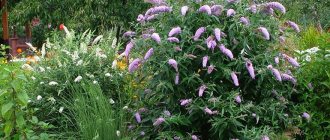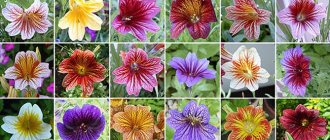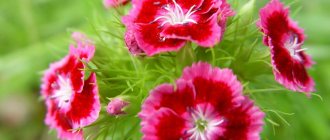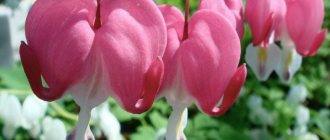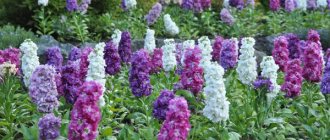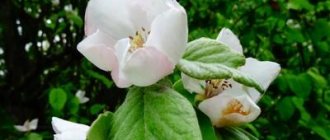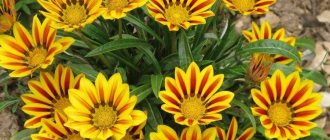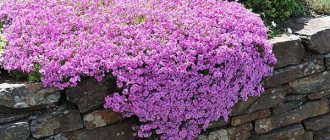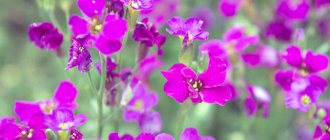- June 19, 2019
- garden plants
- Anastasia Efremenkova
In this article we will talk about the features of a plant such as bergenia, planting and caring for it in the garden. In general, bergenia is a herb and belongs to the Saxifraga family. The herb also has a second name - bergenia. This perennial herb can be found in its natural environment in China, Korea, and Central Asian countries. It prefers rocky soil, so it most often grows in rock cracks. Bergenia entered the culture in the 18th century. It received its second name from the botanist Carl August von Bergen. Now only 10 species of this grass are known, but breeders have managed to develop many more varieties. So, next we’ll find out what care and planting of bergenia in open ground include.
general description
Bergenia can be presented in the form of both perennial and annual plants that have a horizontal root system and can reach a height of 35 centimeters. The leathery leaves of bergenia are collected in basal rosettes; in almost all species, the leaves are dark green and located on long petioles. The flowers are goblet-shaped. The color palette is not too diverse. The most common flowers are white, pink or red. They are collected in paniculate inflorescences. Bergenia blooms begin around the end of May or early June, depending on the climate of the area. Please note that up to 120 flowers can be collected in one inflorescence. Bergenia also has a fruit - a seed capsule.
Quite often, bergenia is used in landscape design. This plant goes especially well with stones and crops such as phlox and hosta. Let's move on to the features of caring for and planting bergenia in open ground.
Planting bergenia in open ground and rules for caring for the plant
In a spring flowerbed, one cannot help but notice large rosettes of lush green foliage, with bright pink inflorescences on dense, erect peduncles. This is an incense plant, planting and caring for it in open ground will not cause any trouble even for a novice gardener. But thanks to this unpretentious, eye-catching and very useful plant, the garden will truly be transformed.
Perennial garden varieties of bergenia come from those parts of Asia where other representatives of the green world would not be too comfortable. Plants settle not only in alpine meadows and lowlands, but also on rocky ledges and highlands. Such conditions “hardened” the flower, often called saxifrage for its endurance.
In landscape design, as in the photo, bergenia has found its place on alpine hills and near ponds, in group plantings with other decorative perennials. Mono-planting of this crop, which grows quickly and forms picturesque clumps of dense foliage, is quite common.
Growing bergenia and caring for it on the site will not make it difficult for the ever-busy summer resident. The main thing is to find a suitable place for the perennial and create conditions for growth and flowering.
Types and varieties of bergenia
Below we will describe the types and varieties of bergenia that can most often be found in cultivation.
- Badan Strechi. It has oblong, ovoid leaves. Small teeth can be seen along the edges of these leaves. The length of the leaf is 8-10 centimeters, and the width is only 3-5 centimeters. Peduncles can reach 40 centimeters in height. They bear white or lilac-pink flowers, which are collected in racemose inflorescences. Among the best varieties of the species, Alba, Belvedere and Beethoven should be highlighted. Belvedere is different in that it grows in height to only 20 centimeters. And its white flowers gradually, during the flowering process, become pink.
- Bergenia thickleaf. Planting and caring for thick-leaved bergenia does not cause any problems. In addition, this type is most often used in medicine. It differs from other species in that it has two types of shoots: leafless flowering and vegetative rosette. On the vegetative shoots there are rather large leathery leaves that have an obovate shape. Their bright green color turns fiery red in autumn. The flowers are bell-shaped and collected in dense inflorescences. The best varieties are considered to be: Hydroruspe (a fairly tall plant - up to 60 centimeters, blooms for almost two months), Purpurea (the shrub can reach half a meter in height), Senor.
- Bergenia cordifolia. This is a variety of thick-leaved bergenia. It has rounded dark green leaves. Lilac, bell-shaped flowers are collected in racemes. Flowering begins in May. This plant came into cultivation in 1779.
- Hissar bergenia. One of the rarest species. It has rosette leaves, obovate in shape, covered with thick cilia along the edges. The flowers are located on peduncles 20 centimeters long. 6-8 white or pinkish flowers are collected in racemose inflorescences.
- Bergenia hybrid. This species includes varieties that are most often found in cultivation: Abenglut (its bright green leaves acquire a bronze-brown tint by autumn and has double flowers); Frau Holle (distinguished from other varieties by its snow-white flowers); Morgen Rothe (this variety blooms twice per season); Baby Doll (has beautiful flowers that are pale pink at the beginning of flowering and later become dark cream).
Flower varieties
In addition to the heart-leaved variety, bergenia can be thick-leaved and Pacific.
- Thick-leaved bergenia has dark pink inflorescences that are framed by shiny light green leaves that turn reddish-brown in autumn. The flowers give off a wonderful aroma. They grow 50 centimeters in height from the ground.
- Pacific bergenia has bright, pale lilac flowers that resemble bells. The leaves are large, rounded in size: 20 centimeters in diameter.
Sowing seeds
It is recommended to sow bergenia before winter. Choose a suitable box and fill it with flower soil. Next, it is necessary to make grooves in the soil, the depth of which should not exceed five millimeters. The distance from one groove to another should be three centimeters. After they are ready, you should spill them with warm water, and then lay out the seeds and immediately sprinkle them with soil. After planting, the box must be taken outside and placed under the snow. At the beginning of March, it will need to be brought indoors and placed in partial shade. The air temperature in the room should not fall below +18-19 degrees.
How to prepare and store raw materials
Rhizomes and leaves are harvested separately.
Roots
When the bergenia fades, you can dig up the rhizome. This should begin at the end of June. The roots are washed, finely chopped, and then dried outside or in a dryer (temperature does not exceed 30°C). Drying lasts about a month. Store the roots in a container with a tightly closed lid. Properties can be maintained for 3 years.
Leaves
The leaves are dried on a thin layer of paper or wood. The required temperature is 30°C. The resulting material is stored in a paper bag or glass jar. It is necessary to limit access to moisture. Storage reaches 3 years.
Bergenia seedlings
Within three weeks after you bring the box of bergenia into the house, the first shoots will appear. Caring for bergenia seedlings is not difficult. It is necessary to periodically loosen the soil and carry out timely watering. But remember that you need to moisten the soil only when its top layer is dry. Also, do not forget to ventilate the room and remove weak shoots so that they do not interfere with the development of stronger ones. Sometimes it happens that a green crust appears on the surface of the earth. It indicates that the root system receives too much water, and because of this, oxygen ceases to flow to the roots.
Badan in landscape design
Bergenia flowerbed in a garden plot
The decorative flower looks great in the design of gardens, flower beds and stone compositions. Thanks to the creeping form of the root system, the plant densely covers the ground, preventing weeds and other harmful grasses from developing.
Bergenia looks great both as part of a flower bed with other ornamental crops, and as a single plant, covering, for example, an uneven layer of soil with a beautiful, uniform carpet of green leaves.
Among other things, ease of care and unpretentiousness to the composition of the soil makes it possible to grow bergenia in almost any conditions. It can grow both in shade, partial shade, and in areas illuminated by sunlight. The main thing is to adjust the principles of basic plant care in accordance with the conditions of its maintenance.
Bergenia gets along well with the following decorative flowers in the flowerbed:
- astilbe;
- hellebore;
- fern;
- lungwort;
- juniper and others.
Not the best combination for bergenia would be lilies of the valley, periwinkle and other creeping plants that are short in stature. They will suppress each other, preventing them from growing. Flowering will develop poorly and the result of such a tandem will not please the gardener.
Bergenia pick
In May, the first picking of bergenia seedlings is carried out. They are transplanted into a new box. The distance from one seedling to another should be 5-7 centimeters in a row. But the distance between the rows is 15 centimeters. Decide in advance when you will plant bergenia in open ground. Because a few weeks before this, you should start hardening off the seedlings. The box with seedlings is taken out onto the loggia or balcony. It is better to start with one hour of stay there, gradually increasing the time. When the seedlings have been on the balcony for a day, you can safely start planting them in open ground.
Preparing garden bergenia for winter
Bergenias are frost-resistant, but in winters with little snow, some cultivated varieties may freeze. To prevent the curtain from looking bare in the spring and then not being restored for several years, it is recommended to insulate young plants that have not had time to fully acclimatize. This can be done using a thick layer of mulch, for which fallen and dried leaves, spruce branches, and high-moor peat are used.
Planting and growing bergenia - video
Bergenia is considered one of the most interesting flowering plants that will decorate a summer cottage or flower garden. Therefore, in this article we will talk about bergenia planting and care in open ground , which is not so difficult. The main thing is to know the technology and respect the proximity to other flowering and non-flowering crops.
Disembarkation time
Caring for and planting bergenia plants should not cause you any difficulties. By following simple rules, you can easily achieve success. In general, experienced gardeners recommend planting bergenia at the end of August, since the seedlings develop rather slowly. But if you see that you have strong seedlings, you can plant them in June. As for everyone else, it is better to carry out another pick and let the seedlings grow and get stronger. Bergenia seedlings will be completely ready for transplanting into open ground in August.
Combination with other crops
Bergenia grows favorably in a flower bed and looks beautiful next to:
- fern;
- lungwort;
- hellebore;
- magnolia;
- astilbe;
- juniper.
You should not plant bergenia close to lilies of the valley and other low-growing and creeping plants, as bergenia will not be able to fully grow and develop.
A well-groomed incense tree looks beautiful under a large tree. The plant will also look picturesque together with bulbous flowers:
Disembarkation rules
So, how do you plant bergenia in the garden and care for the planted seedlings?
The root system of bergenia is quite weak and is located horizontally. Therefore, for planting seedlings, you should choose loose and light alkaline soil. Quite often it happens that the roots of the bergenia begin to peek out from under the ground. You should think about this in advance, since in this position they may overheat in the sun. To prevent this from happening, you should choose a shaded area for planting bergenia. It is better if it is the northern, northeastern or northwestern part of your site. If you cannot plant bergenia in such a place, then immediately after planting, lay a layer of mulch in the root zone. This will allow the soil to dry out more slowly, and the root system will be protected from sunlight. Be sure to take into account the fact that moisture should never stagnate in the roots of bergenia. He can't stand it.
So, he proceeds directly to planting bergenia. It is necessary to make holes in the soil, the depth of which should be 6-8 centimeters. It is better to arrange them in the garden bed in a checkerboard pattern. The bottom of each hole should be covered with a layer of sand, which will act as drainage. The seedlings are transferred into the holes directly with a lump of earth and immediately dug in. Immediately after planting the seedlings, it is necessary to water the beds. The development and growth of bergenia is quite slow, so you will have to be patient. In the first two years there is no need to wait for flowering. Typically, bergenia blooms in the fourth year after planting in open ground.
Rules for planting plants in open ground
Bergenia, although unpretentious to growing conditions, still feels more comfortable and develops faster in its natural environment. Therefore, the main rule for planting this plant is to choose a suitable place and create the necessary natural conditions.
The site for planting should be selected taking into account the following characteristics of the flower:
- Bergenia does not tolerate stagnation of moisture and can die from excess water;
- Clay soil is not suitable for the plant, although in some cases it can be diluted with fine sand or crushed stone, but it is still better to give preference to loose soil;
- bergenia does not like bright sun and is susceptible to drought when exposed to direct sunlight;
- A slightly alkaline substrate is considered ideal for a flower.
Once the site has been selected, you can proceed directly to planting the flower in open ground. There are three ways to do this.
Planting a flower with leaf rosettes
Popular articles How to properly build a closed gazebo for a summer residence, its design and interior
To do this, first dig a spacious hole and fill it with water. Then the plant with rhizomes located in an earthen coma from the previous site is planted in the prepared hole. The roots are covered with soil, and then the soil is compacted. Watering is carried out only after 5-7 days.
Planting prepared seedlings
Planting bergenia in this way is not much different from planting a plant with leaf rosettes. The only difference is the time of such planting: it is recommended to plant bergenia flowers at the end of summer, and seedlings at the beginning.
Planting with rhizomes
For planting a plant using this method, bergenia rhizomes with 4-6 dormant buds are suitable. The planting process itself consists of two stages: preparatory, which includes soaking the roots of the flower in water for several hours, and the main stage - directly planting the plant in the ground.
Rules of care
Usually, planting cordifolia bergenia and caring for it do not cause any problems for the gardener, but this also applies to other types and varieties of this plant. Since bergenia is an evergreen herb, after winter, when the snow melts, damaged leaves remain on it, which should be removed in the spring. You also need to remove shoots that have grown too much or have been damaged. After pruning, complex mineral fertilizer should be applied so that the bergenia can regain its strength and begin to grow. The next feeding will be needed two weeks after the end of bergenia flowering; during this period the plant also needs to regain its strength. Because after flowering, new leaves begin to appear on it. It is better to use Kemira combi as a fertilizer. The solution is easy to prepare. For ten liters of water you will need only one tablespoon of fertilizer. This amount is usually enough for two square meters of flower bed.
A mandatory point when learning the rules for caring for and planting bergenia in open ground is watering. As already mentioned, bergenia does not tolerate waterlogging of the soil, so it needs to be watered only at certain periods. The first time is when the buds begin to form, then when flowering begins, and the third time two weeks after flowering ends. However, even this schedule should be followed if the summer turns out to be dry. If there has been rain, then there is no need to water the bergenia. In the wild, bergenia itself is able to protect its roots. This is possible thanks to dying leaves that remain in the root zone. But in culture, it is customary to remove such leaves in order to maintain the decorativeness and beauty of the area where the plant is planted. When removing such leaves, you need to get rid of the cuttings. But the root system will be perfectly protected by a layer of mulch laid directly under the bushes.
As for planting bergenia seeds, caring for seedlings was described above. There are no difficulties in this option either. However, gardeners prefer to propagate the plant by dividing the bush.
How to properly care?
To grow a healthy bergenia with beautiful and bright inflorescences, it is not enough to plant correctly - a lot depends on the subsequent care of this garden crop in the flowerbed.
Watering
The juicy leaves of bergenia allow this plant to effectively conserve moisture and withstand even the driest periods with temperatures up to 30 degrees.
Watering itself is carried out in the evening or morning, when there is no direct sunlight. When watering, you should not remove the lowest leaf blades of the plant - the bergenia needs them to retain moisture. To water one adult bergenia bush you will need at least a bucket of settled water at summer temperature. Avoid watering with a watering can - moisture should not get inside the plant’s rosettes.
The regularity of watering also depends on the location where the plant is planted and on external climatic conditions. If the bergenia is planted on the north side of the garden in an open area, then watering will need to be done at least once every 2 weeks. Watering is also carried out during the period of active growth and formation of inflorescences, then during flowering and again after it ends.
Top dressing
Most gardeners prefer not to feed bergenia - when there is an excess of nutrients in the soil, bergenia begins to grow into leaf plates, but the abundance of flowering decreases.
If bergenia grows on depleted soils with a low content of vitamins and nutrients, it is recommended to fertilize no more than 2 times a year. The very first fertilizing is always carried out in early spring - even before pruning the plant and before the period of active growth. The second feeding is applied to the soil in the fall (after the bergenia blooms and during the formation of leaf rosettes) to make it easier for the plant to overwinter. In both cases, fertilizing should include complex mineral fertilizers in liquid form.
Organic fertilizers are not applied directly to the soil of the bergenia. Peat, straw, tree bark or compost are used only as a layer of mulch, which retains moisture at the surface of the ground and provides passive feeding.
When choosing a fertilizer dosage, you should always rely on the manufacturer’s recommendations on the fertilizer packaging. If we talk about superphosphate and potassium fertilizers, it is usually recommended to take no more than 20 grams of fertilizer per 1 square meter of soil (taking into account its dilution in 10 liters of water).
Transfer
Bergenia is one of those garden crops that do not tolerate seasonal transplants. This plant can grow successfully in one permanent place for more than 8-10 years, but when planted in a new area it usually does not take root and rots.
But, nevertheless, sometimes there is a need to replant the plant. It is better to replant bergenia to another place only when this crop grows in the flowerbed. This garden crop has a high growth rate and over time can take over the entire flowerbed, interfering with the growth of other plants. In order to plant young bergenia bushes in a new place as painlessly as possible, it is recommended to wait at least 4-5 years from the moment the mother plant is planted in open ground.
Wintering
Most varieties of garden bergenia are frost-resistant and can withstand even critical temperatures down to -40 degrees. The only condition for overwintering such a plant is the presence of shelter in the form of a sufficiently thick layer of snow.
In regions with little snow but harsh winters, the planted bergenia will need additional shelter - the roots of this plant are usually located close to the surface, which is why they can freeze.
For high-quality shelter, ordinary dry leaves or straw may be suitable. From above, cut bergenia bushes are covered with spruce branches, which will protect the plant from cold wind and freezing.
When preparing bergenia for wintering, the stems and buds of the plant are cut short, and the soil near the plant is loosened to destroy the pest larvae that have taken refuge for the winter.
The shelter is removed with the onset of the first warm days.
Reproduction options
Propagation of bergenia can be carried out in two ways: by seeds or vegetatively, i.e. by dividing the bush. From year to year, the bergenia grows more and more, as a result of which new rosettes with a root system are formed. The roots of such rosettes are located quite close to the soil surface, so you can dig them up fairly quickly and not damage the mother rhizome. For division, you should choose middle-aged plants that have large leaves. It is necessary to separate the rosette along with the heel from the mother rhizome. The most suitable period is considered to be May-August.
Please note that each rhizome must have at least three living buds. All leaves of the dug cuttings must be removed; you can leave only two or three, but only the youngest ones. For divisions, holes should be prepared in advance. Their depth should be 3-5 centimeters, and the distance from each other should be 30-40 centimeters. With such a transplant, the bergenia takes root quite quickly, and already in the second year it will be possible to see its flowering. And the first year after planting, the plant grows a rosette.
Planting bergenia in open ground and caring for plants
The root system of bergenia is located close to the soil surface, so you should not make large, deep holes.
It is enough to scoop 6–8 cm of soil and pour a little sand into the bottom of the hole as drainage. Since the plant will gradually expand its boundaries and grow, the interval between holes is made at least 40 cm. After planting, the soil is compacted and watered. Popular articles Selection and use of trees and shrubs in landscape design
If most perennials bloom the next year after planting in the ground, then bergenia is in no hurry to show its inflorescences to the summer resident. The first buds are formed only after 2–3 years, but the bergenia is already forming daughter rosettes.
This is an excellent planting material that can be easily separated from adult plants in the summer, after flowering and before the first days of September. The rhizomes of such divisions are located almost below the surface of the soil or protrude above it, and even a beginner can cope with digging them out.
The plant must be divided so that at least three healthy buds remain on the root cuttings. Leaves are cut off from the seedlings, leaving a pair of the strongest ones. Planting is carried out to a depth of 3 to 5 centimeters. To ensure that the bergenia has room to grow, a gap of at least 30 centimeters is left between future plants. In the first month, fertilizing is not needed, but watering should be regular and plentiful.
With proper care, bergenia planted in open ground blooms a year earlier than seedlings, that is, in the second or third year after the start of independent life.
When to replant bergenia? This plant can grow in one place for a very long time and without visible problems. Therefore, transplantation is undertaken when required:
- limit the growth of bergenia on the site;
- on the contrary, obtain planting material for propagation from adult plants.
Uncontrolled spreading of plantings leads to their excessive density, which is fraught with diseases and the accumulation of pests.
Transplanting bergenia: when is the best time to do it?
Badan does not like frequent transplants, since it is a perennial, it can remain in one place for more than a dozen years. However, it is necessary to take into account the fact that it is growing quite strongly in breadth, capturing territories that did not belong to it. Therefore, it is recommended to replant the bergenia every five to six years. Experienced flower growers claim that the first half of September is best suited for this process - at the same time the bush is divided. Each plant should be 30 centimeters from the other. In the first two weeks, bergenia will need plenty of soil moisture. Now the question of how to plant bergenia does not seem so difficult.
Diseases and pests
As already mentioned, bergenia is an unpretentious garden plant, therefore it is quite resistant to various diseases and insect attacks. However, due to unfavorable growing conditions and the gardener’s failure to comply with all the rules of agricultural technology, problems may arise. First of all, unfavorable conditions include increased soil moisture, which provokes the appearance of various fungal infections. In this case, ramulariasis is considered especially dangerous. It is quite easy to detect the presence of such a disease, since brown spots with a red border appear on the leaves. They are visible on the top of the leaf. But the lower part is covered with a whitish coating.
If treatment is not started promptly, the affected leaves will begin to dry out. All diseased leaves must be immediately removed and destroyed, and the plant itself must be treated with foundationazole or another preparation that contains copper. These include Bordeaux mixture, copper sulfate and copper oxychloride.
If your bergenia grows in partial shade, it may be affected by pests such as nematodes and slobbering pennies. Drooling pennies are easily removed with the help of drugs such as Actellik or Aktarai. The plant will need to be processed in two stages. The interval between treatments should be a week. Spraying can only be done on a dry day. The air temperature should not be lower than +21 degrees and higher than +28 degrees. But getting rid of nematodes is not so easy. Firstly, the affected bush must be dug up and the root system should be kept in a strong solution of potassium permanganate for thirty minutes. After this, the bush is planted in another place, and the soil in which it grew before must be treated with insecticides. But even after treatment, do not rush to plant other plants in this place. It's better to wait a year.
The main diseases affecting bergenia
Badan affected by disease
The plant is very resistant to damage by various pests and pathogens. However, this characteristic is characteristic only of those plants whose maintenance conditions are met to the maximum extent possible.
Sometimes bergenia is damaged by a fungal disease. This is due to insufficient care of the flower. In this case, brown spots appear on the leaves, and on the reverse side the leaves become covered with a light coating. To eradicate the disease, you will have to treat the leaves with a solution with a high copper content and cut off the affected areas.
Collection of bergenia seeds
After flowering, bergenia produces quite a lot of small seeds. For propagation, it is better to choose the largest and most lush inflorescences. A gauze bag is placed on fading flowers to prevent the seeds from falling to the ground when ripe. Seeds are usually collected in September. Just below the place where the bag is tied, you need to cut off the selected inflorescence and bring it into a dry room. There the seeds need to be dried for several weeks. After this, they are taken out of the seed pods, cleaned of excess debris and stored in a dry place.
Properties of bergenia
Bergenia has quite a lot of medicinal properties. They are found in the plant's rhizome, leaves, seeds and flowers. As for the above-ground parts, they contain tannins, flavonoids, manganese, arbutin, iron, copper and many vitamins. And the roots contain polyphenols, tannins, starch and resins.
In folk medicine, bergenia is used for fibroids, enterocolitis, malignant tumors and cervical erosions. This plant is also very effective for bleeding gums and is used to treat lung diseases, influenza, dermatosis, and acute respiratory diseases. Good for headaches, hemorrhoids and fever. It can relieve articular rheumatism and help with various diseases of the gastrointestinal tract.
All drugs made from bergenia have a diuretic, anti-inflammatory, antimicrobial, wound-healing, hemostatic and astringent effect. They also help strengthen capillary walls, lower blood pressure, constrict blood vessels, and also help increase heart rate.
But there are also some contraindications to the use of bergenia. For example, taking drugs based on it for too long can cause constipation. It is also prohibited to use bergenia tinctures for people who have increased blood clotting. If you are hypotensive, then you are prohibited from taking decoctions of bergenia roots, as they lower blood pressure.
So, the article described in detail the features of care and planting of bergenia; a photo of the plant is also in the review. Which gives you an idea of its appearance, behavior in the flowerbed, etc. The appearance of this plant will not leave anyone indifferent. And since even a beginner can plant bergenia in open ground and care for it afterwards, you won’t be able to deny yourself the pleasure of acquiring such a plant.
Chemical composition
The most useful part of this plant is the root. It is rich in valuable chemicals that give Badan medicinal properties.
- Ascorbic acid;
- Glucose and other sugars;
- Bergenin isocoumarin;
- Starch;
- Polyphenols.
About a third of the roots are tannins.
There are other components found in the foliage, of which the third part is tannins.
- Tannins;
- Vitamins of group C;
- Coumarins;
- Flavonoids;
- Carotene;
- Copper, manganese and iron ions;
- Gallic acid.
The plant is rich in essential oils.

